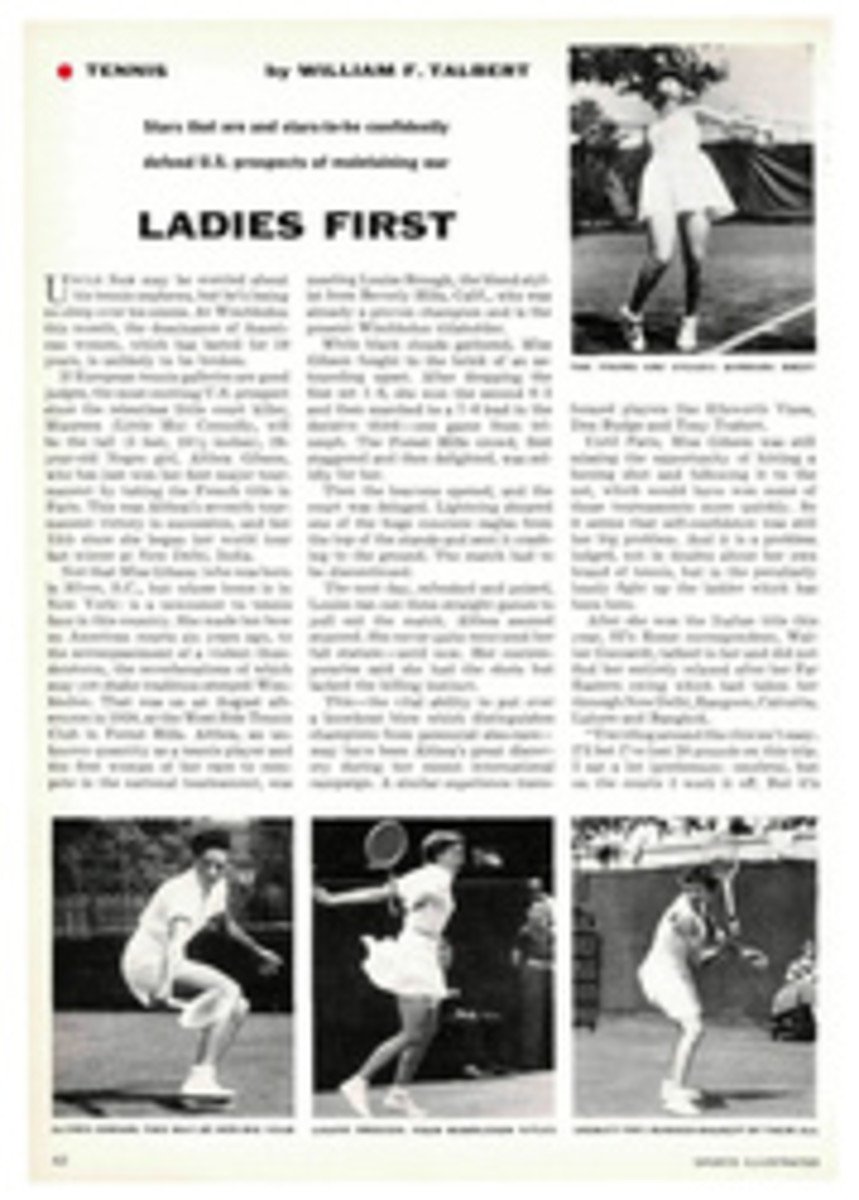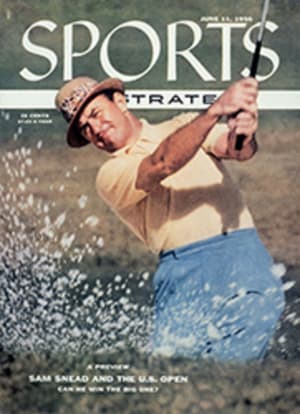
HOLLYWOOD HOKUM
When I promised to fill my old space with a critique (or call it a blast) of The Harder They Fall, I didn't quite realize what I was letting myself in for. A fairly faithful and certainly forceful motion picture has been adapted by Mark Robson, the director, from my novel, and the film has won kudos from New York to Cannes.
But there is simply no pleasing some people. Take this columnist emeritus of SI; him there is no pleasing. As taut and fierce and well acted and vivid in detail as the picture is, it is guilty on at least half a dozen counts of presenting an inaccurate and overstated picture of boxing evils as they exist today.
Let's start with the ads. The picture promised to expose "the swindle that is big-time boxing."
Now I hardly qualify as an apologist for big-time boxing, but to suggest that every fight is fixed, every manager venal and every fighter a victim is to do a large injustice to hundreds of fine fighters and reliable trainers and managers whose careers ride on the unknown outcome of every big fight. If Sugar Ray wins, the Robinson myth sails on. If Olson loses, he's out of the big time for good and all. The big fights of recent years have all—or nearly all—been on the level. There is no moment of greater drama and uncertainty in the whole world of sports than the tingling few seconds when the antagonists dance in their corners waiting for the bell to send them out to do or be undone.
Yes, there have been barneys in boxing—Fox-LaMotta, Graziano-Davey, Paddy Young-Gene Hairston, Art Aragon-Tommy Campbell, Gavilan-Saxton—to name a few. But boxing is not yet a vaudeville. It is a professional sport which too often hides its face from scandal—a sport infected with Carbos and Palermos and their complacent piecemen. And yet—and here The Harder They Fall fell down for me—it's a sport that has served well and been well served by such heroes as Rocky Marciano, Archie Moore, Ray Robinson, Carmen Basilio and a dozen other stalwarts.
Actually, my book was first outlined in 1940-41 as a follow-up to What Makes Sammy Run? It was put aside after Pearl Harbor when the fight world no longer seemed to demand attention. The cobwebs were wiped away in 1946—but the story remained essentially a portrait of the fight game at its base worst in the early '30s.
If I had been making the picture, I would have 1) frankly planned it as a period piece or 2) updated it to a time when rogues still infest the fight biz but when they no longer operate with the crudity of a waterfront mob.
The opening fix in the movie would never get by today. A second who blinds a fighter he is handling as treated in the film would be caught in the act by any capable referee. And no longer is a handler permitted to throw a towel into the ring to signal the defection of his man. This was outlawed in most places years ago for the precise reason that it led too easily to corruption.
While I have heard aroused fight crowds cry "yellow" at a fighter who is doing his honest but poor best, I was unable to believe the scene in which Gus Dundee, the damaged ex-champion (truly played by Pat Comiskey) crumples to the canvas and is carried out on a stretcher while the crowd reviles him as a quitter and a coward. It is an immensely theatrical scene but, alas, it rings like a $9 bell. It has been my misfortune to see a number of fighters carried out of the ring on stretchers. I was sitting in Willie Pep's dressing room last fall in Tampa when Ferman King was thus removed. There was a typical rowdy fight crowd. But nobody threw nothing, nobody said nothing. There was a hush. Death (two days later) was in the air. When a fighter goes down and fails to get up, when he's down so long as to need a stretcher (Bogey and Mark, listen this time: this is true) even the crassest and cruelest of fans knows something most terrible is wrong. When (in the picture) a fat woman curses the dying ex-champ on his way up the aisle, nobody will ever say that isn't dramatic. But no one who knows the fight game will say it is true.
The Harder They Fall is being advertised as a picture that pulls no punches. I agree. But some of the punches are illegal because the gloves are loaded. In the book, for instance, it was enough that the tame giant was being thrown into the ring with the champion sans handcuffs—somewhat as a built-up Davey was thrown to Gavilan, who needed no dramatic gimmick for wanting to demolish him. The Keed was just so much the superior professional fighter that he could not help destroying Davey—even with his inability to hit the long ball. But what do we have in the film The Harder They Fall? A Maxie Baer overplaying Max Baer saying he wants revenge on Toro (my giant) Moreno because Toro's press agent is taking the credit for killing Old Gus in the ring. It was his, Maxie's, punches what really put Gus under the daisies, argues Max. And he wants the glory as the true minister of death.
Birdseed. I have known boxers pretty well over a 30-year span. I have put in some hours with Fidel LaBarba, Mickey Walker, George Godfrey, Billy Soose, Jackie Fields, Roger Donoghue, Willie Pep, Lee Oma, Abe Simon, Rocky Marciano—all kinds: intelligent, limited, cagey, generous; fighting fools, careful fencers, brilliant, pedestrian—all kinds. Some of them have figured in fatalities or near fatalities. Not one ever voiced any other sentiment but anguish for any permanent damage inflicted on an opponent. Indeed, the men I have known who have suffered the death of an opponent in the ring are obsessed with the tragedy, haunted by the specter of the dead man's face.
So in the name of the boxing fraternity that has no idea I am scribbling these words, I accuse The Harder They Fall film makers of sensationalism above and beyond the call of dramatic art when they twist a heavyweight champion of the world into a leering psychopath. Maxie Baer, who queens through this incredible part, may have been a tamed tiger but he wasn't a monster.
Another point: the unrehearsed candid-camera scene of one Joe Greb, the broken-faced wino, on Skid Row is capsule sociology and lightning theater. A nice touch. But anyone who draws from the frightful scene the conclusion that all old fighters are toothless, penniless punchies should attend the next session of the Veteran Boxers Association. I respect old fighters and I long to see a home for the needy ones, based on the Motion Picture Relief Fund idea. But I know that some of the chief contributors will be veteran boxers themselves who are thriving in a score of enterprises from acting to banking.
Another fundamental difference between the novel and the film: the book opens with a loving account of classic encounters between Frank Slavin and Peter Jackson, Corbett and Choynski. Toro Moreno's benighted career is backlighted with tales of fistic courage, of Charlie Goldmanlike devotion. The book is sprinkled with affectionate vignettes from the liniment world of Eighth Avenue. You can only hate truly the things you love. I accuse my talented friend Mark Robson of making his film out of hating for the sake of hating, without taking the trouble, the artistic trouble, the Dostoevskian trouble of first learning to love that which he would destroy.
It's a helluva picture, Mark—taut, tense, terse, tough, tenacious, terrifying. I think people ought to see it. As long as they know enough not to confuse truculence with truth.
One final nip of the fingers that feed me: in the original film ending, the press agent braved the vengeance of the mob by writing an expose which began with the flaming phrase: "Boxing must be abolished in America." I filed a protest, partly because this line was typed under the manuscript title of The Harder They Fall, smudging this writer's identity with that of Bogart's press agent. My own belief, not new to these columns, is that boxing can no more be abolished than booze, sex, religion and other hungers, for good or evil, in the soul and tissue of man. Boxing has been abolished, repeatedly, and each time has sprung up in rampant, bootleg form. The accommodating producers revised the line to read: "The boxing business must rid itself of...evil influence—even if it takes an act of Congress to do so." It would be churlish even to cite this act of graciousness on the part of Columbia Pictures if so many critics had not based their reviews on press showings before the offending peroration was brought a little closer to my original intention. The result has been a stream of letters asking how I reconcile "abolishment of boxing" with my qualified support for the game in the pages of this magazine.
Boxing needs no act of Congress. It simply needs what baseball needed 35 years ago—a Landis, a Helfand-type commission in authority to bring boxing into line throughout the land. Plus a front office wise enough to cooperate in the rehabilitation of the juvenile delinquent of American professional sport.
If The Harder They Fall, with its exaggerated but undeniable dramatic power, calls attention to this need, it may have served its purpose as a haymaking narrative of the worst that can happen.
ILLUSTRATION
"One way or another, I've never fallen below my sales quota."

